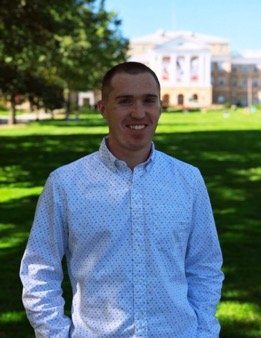Meet a Participant: James Brunner

The mathematics of microbes: an investigation in microbiomes
When James Brunner began on his path of higher education, he knew he was interested in biology and medicine. While pursuing his undergraduate degree, he intended to apply to medical school to become a doctor. As his studies continued, he realized that he was more fascinated by the theoretical problems that biology and medicine presented than by the direct implementation. Inspired, Brunner turned to mathematics to answer his curiosity and questions.
Brunner now pursues a doctoral degree in applied mathematics at the University of Wisconsin, Madison. He focuses on mathematical biology and bioinformatics.
Brunner discovered an opportunity to perform interdisciplinary research and merge his passions. The National Science Foundation’s (NSF) Mathematical Sciences Graduate Internship (MSGI) Program provides research opportunities for mathematical sciences doctoral students to participate in internships at national laboratories, industries and other facilities. NSF MSGI seeks to provide hands-on experience for the use of mathematics in a nonacademic setting.
Brunner’s internship took place at Los Alamos National Laboratory in Los Alamos, New Mexico, where he collaborated with biologists to perform research on microbiomes. A microbiome is a group of microorganisms in a particular environment, including human, animal, and natural or built environments. Microorganisms coexist in a network in each microbiome. Microorganisms are essential for life on Earth, and they include those that reside in human bodies.
With his mentors, Patrick Chain, Ph.D., and Karen Davenport, Brunner investigated the use of network inference and analysis as applied to microbiomes. They sought to determine how networks can be used to improve taxonomic classification from samples taken in various microbiomes. The samples contained genetic material recovered directly from microbiomes, which made it possible to try to classify the microorganisms inside. By studying the microorganisms and their resulting microbial networks, identification of microorganism taxa and classification can be improved. The more microorganisms that can be classified, the more researchers can understand about differences between different microbiomes and microbial communities.
During his internship, Brunner collaborated with biologists and computer scientists. He spent most of his day researching computational problems that would enable the team to build and subsequently analyze microbial networks. Overall, improved understanding of microbial communities can provide diagnostic tools to enhance detection of pathogens in clinical samples, as well as advance agricultural practices by investigating environmental samples.
Brunner appreciated the program for the chance it provided to apply mathematics in a meaningful way and learn how mathematics can be used to answer questions in the biosciences.
“This program gave me the experience of working directly with biologists, and it taught me not only what sort of questions biologists are asking, but how they are asking them and how they expect to use mathematical tools to find answers,” Brunner said. “I would certainly recommend the experience to other young mathematicians.”
Brunner returned to the University of Wisconsin, Madison, to finish his doctoral degree. After his graduation in 2018, Brunner hopes to obtain a postdoctoral position and continue applying mathematics to biology through collaboration with biologists at a research institute or laboratory.
The NSF MSGI Program is funded by NSF and administered through the U.S. Department of Energy’s (DOE) Oak Ridge Institute for Science and Education (ORISE). ORISE is managed for DOE by ORAU.


